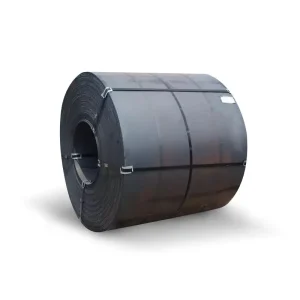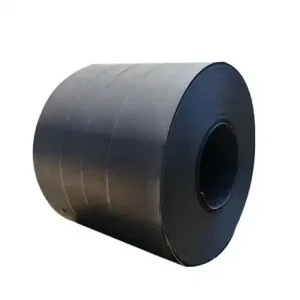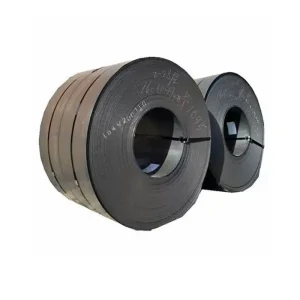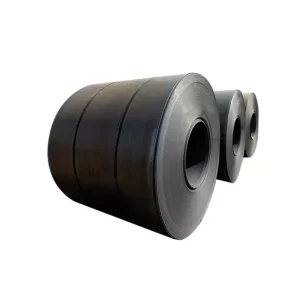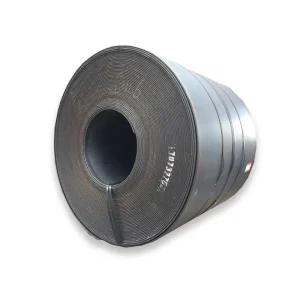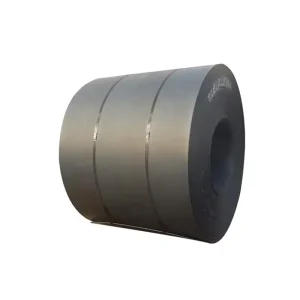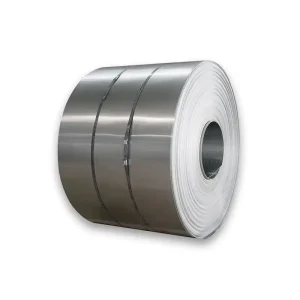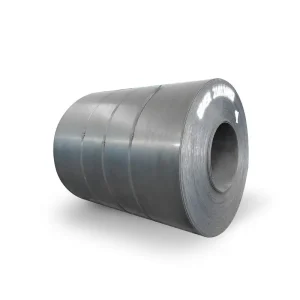Carbon Steel Coil
Products
Carbon steel coil is the most cost-effective, widely used flat steel product for structural parts, formed components, and coated assemblies — select the coil type (hot-rolled, pickled & oiled, cold-rolled, galvanized or prepainted) by matching required mechanical performance, surface finish, and downstream processing demands.
What is carbon steel coil
A carbon steel coil is a length of steel sheet or strip wound into a roll after rolling operations at the mill. Coils are the primary commercial form for flat products; they feed downstream processes such as slitting, cut-to-length, press blanking, and coil coating. The industry treats “coil” as the standard intermediate form across hot-rolled, cold-rolled, and coated product lines.
Standards that matter
-
ASTM A1011 / A1011M — principal U.S. specification covering hot-rolled sheet and strip (commercial, drawing, structural grades). It lists grades by yield strength and intended use; typical thicknesses are for light-gauge products up to ~6 mm.
-
ASTM A1008 / A1008M — standard for cold-rolled carbon sheet and strip; this covers commercial steels and drawing steels commonly used when smooth surface and tighter dimensional control are required.
-
ASTM A653 / A653M — specifies zinc-coated (hot-dip galvanized) coil and galvannealed coil; critical when corrosion protection is required for exposed or painted parts.
-
EN 10130 — European standard for cold-rolled low carbon steel flat products intended for cold forming; commonly referenced in automotive and appliance supply chains.
Grade families — composition and behavior (practical selection rules)
-
Mild / low-carbon steels (SAE/AISI 1006–1018 family): low carbon (≈0.06–0.20% C), good ductility, high formability, easy welding; common for deep drawing and general fabrication. Typical examples: 1008, 1010, 1018.
-
Commercial steels (A1011 CS Types A–D): mill classification emphasizing cost and general utility. Type selection trades off carbon for strength.
-
Structural grades (A1011 SS Grade 36 etc.): higher guaranteed minimum yield, used where load capacity matters (frames, supports).
-
High-strength low-alloy (HSLAS): used where weight reduction is required while keeping formability.
Selection rule: If your part needs heavy forming (deep draw, stamping) pick low-carbon cold-rolled drawing steels or DC-grade equivalents; if structural load bearing is the priority, choose higher grade hot-rolled structural coil.
How coils are made — steps that affect specifications and price
-
Hot rolling — slab reheated and passed through hot strip mill; results in hot-rolled coil with scale on the surface. Hot-rolled coil is economical and frequently used where surface finish is non-critical.
-
Pickling / P&O (pickled & oiled) — acid pickling removes mill scale; oiling provides light corrosion protection and eases coil handling. Pickled coils are preferred when surface cleanliness matters.
-
Cold rolling — reduces thickness, improves surface finish, tightens tolerances; cold-rolled coil is what large appliance and automotive suppliers require.
-
Annealing / skin-pass — restores ductility after cold work and controls final mechanical properties and surface texture.
-
Coating (galvanizing, galvannealing, organic coil coating) — applied continuously to coil for corrosion resistance or to provide a paintable substrate (prepainted metals).
Processing decisions (skip pickling, cold roll, or coil coating) are major cost drivers — specify only what you need.
Surface states, coatings, and finishes
-
Hot-rolled (HR) — as-rolled, painted, or pickled
-
Pickled & oiled (P&O) — clean bright surface with protective oil for storage
-
Cold-rolled (CR) — full hard / half-hard / dead-soft finishes
-
Galvanized (GI) — hot-dip zinc (A653) — classic long-term rust protection
-
GAlvanneal (GA) — zinc-iron alloy — improved paint adhesion for coil coating
-
Prepainted steel (PPGI / PPGL) — factory applied organic coating to coil; useful for architectural or decorative panels.
Typical dimensions, tolerances and packaging (table)
| Product form | Typical thickness range (mm) | Typical width range (mm) | Common coil weight (kg) |
|---|---|---|---|
| Hot-rolled coil | 1.5 – 12 (thin gauge HR < 6 mm common) | 600 – 2100 | 5,000 – 30,000 |
| Cold-rolled coil | 0.25 – 3.0 | 600 – 1500 | 2,000 – 10,000 |
| Galvanized coil | 0.20 – 2.00 | 600 – 1500 | 2,000 – 10,000 |
Note: exact ranges vary by mill and specification; EN and ASTM standards list permitted dimensions and purchaser must state required tolerances when ordering.
Carbon Steel Coil Price Comparison — 2025
| Product / Typical grade names | USA (USD / metric tonne) — typical spot range | China (USD / metric tonne) — typical spot range | Europe (EUR / metric tonne) — typical spot range (approx USD shown) |
|---|---|---|---|
| Hot-Rolled Coil (HRC) — e.g. ASTM A1011 / HR grades (1008–1018 equivalents) | $840 – $975 / t. (mill spot offers and CSP references mid-2025). | $380 – $520 / t (domestic Chinese HRC spot assessments; low-end Chinese domestic offers frequently sit well below U.S. spot levels). | €535 – €722 / t ≈ $615 – $830 / t (using mid-2025 EUR→USD ≈ 1.15). Market shows regional variation by country and importer activity. |
| Cold-Rolled Coil (CRC / drawing steels) — e.g. ASTM A1008 / EN DC01 | $1,050 – $1,130 / t (cold-rolled premium vs HRC in the U.S.). | $500 – $640 / t (China CRC domestic indices; example mid-2025 figures ~ $516 / t reported for China CRC). | €620 – €730 / t ≈ $713 – $840 / t (import & domestic CRC assessments in Northern Europe show this band). |
| Hot-Dip Galvanized Coil (HDG / GI / galvannealed) — e.g. ASTM A653 / GA | $980 – $1,110 / t (galvanized usually a modest premium over HRC in the U.S.). | $480 – $700 / t (China domestic HDG offers and export pressure keep this band broad). | €670 – €722 / t ≈ $770 – $830 / t (European HDG assessments clustered around these levels in early-to-mid 2025). |
| Notes / narrow specialty coils (prepainted PPGI, high-strength, very narrow widths) | Premiums apply: +$50–$200 / t depending on paint system, testing, and order size. (varies by supplier). | Premiums but China can still undercut landed cost due to low domestic mill selling prices; export offers depend on quotas/tariffs. | Premiums for certified automotive/architectural coils; local production shortages or high import activity can widen spreads. |
Fabrication behavior — forming, welding, and heat treatment tips
-
Forming: low carbon cold-rolled drawing steels have the highest deep-draw performance; use appropriate lubrication and press force control to avoid edge cracking.
-
Welding: mild carbon coils weld easily with common processes (MIG, TIG, stick); high carbon increases preheat requirements. For galvanized coils, weld spatter and zinc fumes require fume extraction.
-
Heat treatment: most carbon coil parts are not subject to post-fabrication heat treatment; where strength upgrade is needed, select higher grade strip or consider quenched-and-tempered steels (different product class).
Quality control, tests to require in purchase order
When you buy coil for critical parts, specify the tests and documentation you need:
-
Mill test certificate (chemical analysis and mechanical test results)
-
Tensile test (yield, tensile, elongation) and hardness where relevant
-
Surface quality class (bloom, scratches, mill scale removal)
-
Coating mass or coating thickness for galvanized/organic coatings (e.g., g/m² per ASTM A653)
-
Dimensional tolerances and slit width precision for slit coils
Storage, handling, corrosion control and logistics
-
Store indoors on wooden dunnage or painted racks; rotate stock (FIFO) to avoid long-term contact corrosion.
-
Protect coil ends and ID/OD with banding and end sheets during shipping.
-
Minimize standing water and avoid direct contact with concrete floors.
-
For galvanized coils, avoid high humidity and acids which accelerate white rust.
Commercial considerations — price drivers and specification drafting
Price drivers: raw iron ore and scrap costs, mill capacity and lead time, required processing steps (pickling, cold rolling, annealing, coating), and coil weight/width customization. Long lead times and narrow widths or specialty coatings increase per-kg price. For global purchasing, freight and tariffs often dominate landed cost for commodity coils.
How to write POs: reference the standard (e.g., “ASTM A1008/A1008M-23 cold-rolled, CS Type B”), state required grade, thickness, width tolerances, surface finish, coating type & mass (if any), packing, MTC level (e.g., EN 10204 2.1/2.2/3.1), and required tests.
Comparison tables
Table A — Common grade comparison
| Grade / Spec | Carbon range (% wt) | Typical use | Strength / Formability |
|---|---|---|---|
| SAE-AISI 1008 / 1010 | 0.05 – 0.13 | General stampings, formed parts | High formability, low strength |
| SAE-AISI 1018 | 0.15 – 0.20 | Shafts, pins, mild structural | Balanced strength and ductility |
| A1011 CS Type B | ~0.07–0.18 | General hot-rolled coil use | Moderate formability |
| A1011 SS Grade 36 | up to ~0.20 | Structural sheet applications | Higher yield (36 ksi) |
Table B — Surface/coating quick reference
| Finish | Best for | Typical spec |
|---|---|---|
| HR (hot rolled) | welded structures, low appearance needs | ASTM A1011 |
| P&O | downstream painting, blanking | Pickled & oiled surface |
| CR (cold rolled) | visible surfaces, deep drawing | ASTM A1008 |
| GI (hot-dip zinc) | outdoor corrosion protection | ASTM A653 |
| GA (galvannealed) | coil coating adhesion | ASTM A653 (galvanneal designation) |
| PPGI (prepainted) | architectural panels, appliances | Customer paint spec over coated substrate |
FAQs
-
Q: Hot-rolled or cold-rolled coil — which should I choose?
A: If you need low cost and surface finish is secondary, choose hot-rolled. For tight tolerances, bright surfaces, or deep drawing, cold-rolled is the correct pick. Reference the forming and final appearance requirements in your PO. -
Q: How do I specify galvanized coil performance?
A: Specify ASTM A653 designation, required coating mass (g/m²), and whether you want galvanneal. Also require coating adhesion and paintability tests if you will paint. -
Q: What tolerance range should I expect on thickness?
A: Tolerances depend on standard and mill; cold-rolled tolerances are tighter than hot-rolled. Always state the tolerance bands or reference the ASTM/EN clause. -
Q: Can I order slit coils to custom widths?
A: Yes. slitting is standard. Specify final slit width, edge condition (sheared/razor), and target tolerances. -
Q: What documentation should accompany a batch of coil?
A: A mill test certificate with chemical and mechanical test results, coating certificate (if coated), and any non-conformance records. For critical projects, request an EN 10204 3.1 inspection certificate. -
Q: How do coil processing steps affect part quality?
A: Cold rolling and annealing improve flatness and formability; pickling removes scale and reduces surface defects. Coil stress induced by coiling can later influence flatness; request leveling if dimensional stability is critical. -
Q: Which grades are best for welding?
A: Low carbon steels (1008–1018, A1011 CS Type B) weld readily; higher carbon content needs preheat/controlled cooling for critical welds. -
Q: What are common failure modes in coil-fed production?
A: Coil breaks, edge cracking during forming, coating delamination (for painted coils), and dimensional drift from poorly leveled coils. Prevent by setting incoming inspection checkpoints. -
Q: How long will coil last in storage?
A: Under dry indoor conditions with light oiling, mild coils can keep for months; galvanized or prepainted coils have better shelf life. Control humidity and avoid water pooling. -
Q: Are there environmental or regulatory notes to consider?
A: For galvanized and painted coils, check VOC and RoHS requirements for coatings and end-use jurisdiction; for exported coils, check customs classification and any anti-dumping measures.
Practical procurement checklist
-
Reference standard and edition (ASTM/EN + year).
-
Specify grade and exact chemical limits or MTC acceptance criteria.
-
State thickness range, tolerance, and width/slit widths.
-
Specify surface finish and coating (include coating mass).
-
Request MTC (EN 10204) level and non-conformance reporting.
-
Include packaging and delivery requirements (coil weight, banding, paint on end, dunnage).
-
Add inspection rights and third-party testing if critical.
Additional technical notes for engineers
-
Decarburization: Hot-rolled coil may have decarburized surface layer; for surface-critical machining, specify decarburization limits or select cold-rolled material.
-
Springback: Coil-formed parts will spring back depending on yield; validate with prototypes.
-
Coating thickness vs. corrosion life: Higher zinc mass increases service life; consult ASTM A653 tables for coating designations and equivalences.

